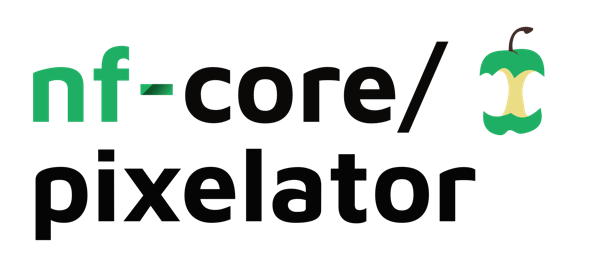nf-core/pixelator is a bioinformatics best-practice analysis pipeline for analysis of Molecular Pixelation assays.
It takes a samplesheet as input and will process your data using pixelator to produce final antibody counts.
- Build amplicon from input reads (
pixelator amplicon) - Read QC and filtering, correctness of the pixel binding sequence sequences (
pixelator preqc | pixelator adapterqc) - Assign a marker (barcode) to each read (
pixelator demux) - Error correction, duplicate removal, compute read counts (
pixelator collapse) - Compute the components of the graph from the edge list in order to create putative cells (
pixelator graph) - Call and annotate cells (
pixelator annotate) - Analyze the cells for polarization and colocalization (
pixelator analysis) - Report generation (
pixelator report)
Warning
Since Nextflow 23.07.0-edge, Nextflow no longer mounts the host's home directory when using Apptainer or Singularity.
This causes issues in some dependencies. As a workaround, you can revert to the old behavior by setting the environment variable
NXF_APPTAINER_HOME_MOUNT or NXF_SINGULARITY_HOME_MOUNT to true in the machine from which you launch the pipeline.
Note
If you are new to Nextflow and nf-core, please refer to this page on how to set-up Nextflow. Make sure to test your setup with -profile test before running the workflow on actual data.
First, prepare a samplesheet with your input data that looks as follows:
samplesheet.csv:
sample,design,panel,fastq_1,fastq_2
uropod_control,D21,human-sc-immunology-spatial-proteomics,uropod_control_300k_S1_R1_001.fastq.gz,uropod_control_300k_S1_R2_001.fastq.gz
Each row represents a sample and gives the design, a panel file and the input fastq files.
Now, you can run the pipeline using:
nextflow run nf-core/pixelator \
-profile <docker/singularity/.../institute> \
--input samplesheet.csv \
--outdir <OUTDIR>Warning
Please provide pipeline parameters via the CLI or Nextflow -params-file option. Custom config files including those provided by the -c Nextflow option can be used to provide any configuration except for parameters;
see docs.
For more details and further functionality, please refer to the usage documentation and the parameter documentation.
To see the results of an example test run with a full size dataset refer to the results tab on the nf-core website pipeline page. For more details about the output files and reports, please refer to the output documentation.
nf-core/pixelator was originally written for Pixelgen Technologies AB by:
- Florian De Temmerman
- Johan Dahlberg
- Alvaro Martinez Barrio
If you would like to contribute to this pipeline, please see the contributing guidelines.
For further information or help, don't hesitate to get in touch on the Slack #pixelator channel (you can join with this invite).
If you use nf-core/pixelator for your analysis, please cite it using the following doi: 10.5281/zenodo.10015112
An extensive list of references for the tools used by the pipeline can be found in the CITATIONS.md file.
You can cite the nf-core publication as follows:
The nf-core framework for community-curated bioinformatics pipelines.
Philip Ewels, Alexander Peltzer, Sven Fillinger, Harshil Patel, Johannes Alneberg, Andreas Wilm, Maxime Ulysse Garcia, Paolo Di Tommaso & Sven Nahnsen.
Nat Biotechnol. 2020 Feb 13. doi: 10.1038/s41587-020-0439-x.










